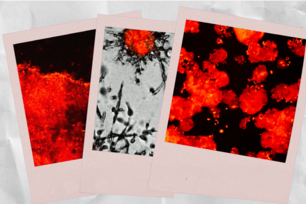There goes the neighborhood: Changes in chromosome structure activate cancer-causing genes

According to Whitehead Institute researchers, a mutation in the genome's three-dimensional structure can activate previously silent oncogenes.
Abe Weintraub/Whitehead Institute
CAMBRIDGE, Mass. – In a finding with enormous implications for cancer diagnostics and therapeutics, Whitehead Institute scientists have discovered that breaches in looping chromosomal structures known as “insulated neighborhoods” can activate oncogenes capable of fueling aggressive tumor growth.
“This new understanding of the role of chromosome structure in cancer gene misregulation reveals the powerful influence of the genome’s structure in human health and disease,” says Whitehead Member Richard Young, whose lab’s research is reported online this week in the journal Science.
Young’s most recent findings build on previous work in which the lab charted human genome structure and described its influence on gene control in healthy cells. By mapping the genome’s three-dimensional (3D) conformation, researchers found that key genes controlling cell identity are found in insulated neighborhoods, whose loops are maintained through anchor sites bound by the protein CTCF. All essential gene regulation, including control of proper activation and repression, takes place within these enclosed neighborhoods.
The scientists had also found that these CTCF loop anchor sites are maintained across various cell types in the human body and highly conserved in primate genomes, emphasizing their importance in normal development. Such widespread structural conservation led the researchers to hypothesize that disruptions in genome conformation might be associated with disease, including cancer.
Sure enough, subsequent systematic genomic analysis of >50 cancer cell types revealed mutations affecting CTCF anchor sites, leading to the loss of insulated neighborhood boundaries. Such neighborhood breaches were found especially frequently in T-cell acute lymphoblastic leukemia, esophageal and liver carcinoma, and in some cases allowed enhancer elements to contact and activate previously silent oncogenes.
“We hadn’t known if these types of mutations contributed to cancer,” says Young. “Now we have multiple examples where these disruptions activate oncogenes that play major roles in tumorigenesis.”
Researchers in Young’s lab note that this oncogenic mechanism is not only widespread in cancer, but may be valuable for identifying the key genes that drive poorly understood cancers.
“In some cancers, such as esophageal carcinoma, the most frequent genetic mutation occurs at the CTCF sites, which is quite striking,” says Denes Hnisz, a postdoctoral researcher in the Young lab and co-first author of the Science paper. “In addition, there are still many cancers whose driver mutations and oncogenes are not known and mapping altered structures may reveal the key oncogenes in these cancers.”
In a final step confirming the relationship between structural disruption and oncogenesis, Hnisz and co-first author Abe Weintraub, a graduate student in Young’s lab, used genome editing techniques to introduce CTCF anchor site deletions in non-malignant cells. These mutations were sufficient to activate oncogenes that are silent in normal cells.
The new findings suggest that future mapping of genome structure in individual patient cancers may improve diagnosis and help guide treatment protocols. “Now that we understand how perturbations in the genome’s structure can contribute to oncogenesis, we’re developing strategies to efficiently diagnose and potentially fix these faulty neighborhoods,” says Weintraub.
This work was supported by the National Institutes of Health (grants HG002668, CA109901, HG003143, NS088538, MH104610, and AI120766), an Erwin Schrödinger Fellowship from the Austrian Science Fund, Ludwig Graduate Fellowship funds, the Laurie Kraus Lacob Faculty Scholar Award in Pediatric Translational Research, Hyundai Hope on Wheels, an Individual Postdoctoral grant, and a Sapere Aude Research Talent grant from the Danish Council for Independent Research, Medical Sciences.
* * *
Richard Young’s primary affiliation is with Whitehead Institute for Biomedical Research, where his laboratory is located and all his research is conducted. He is also a professor of biology at Massachusetts Institute of Technology.
* * *
Citation
Hnisz, D., Weintraub, A. S., Day, D. S., Valton, A. L., Bak, R. O., Li, C. H., ... & Young, R. A. (2016). Activation of proto-oncogenes by disruption of chromosome neighborhoods. Science, 351(6280), 1454-1458.
Topics
Contact
Communications and Public Affairs
Phone: 617-452-4630
Email: newsroom@wi.mit.edu


